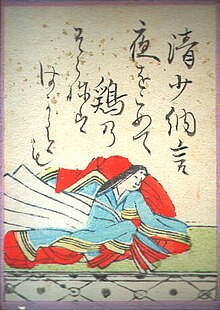Publisher: Penguin Classics; Penguin Classics edition (29 Sept. 1977)
Language: English
ISBN-10: 0140442367
ISBN-13: 978-0140442366
411 pages
About Sei Shōnagon She was a Japanese author, born in Kiyohara Nagiko (清原 諾子) poet and a court lady who served the Empress Teishi (Sadako) around the year 1000 during the middle Heian period. She is the author of The Pillow Book .
Her family name was Kiyohara, her father being Kiyohara no Motosuke (908-990 CE) who was himself a waka poet of some repute and co-author of Gosenshu, an imperial anthology. Her grandfather, Kiyohara no Fukayabu, was an even more renowned poet.
Sei Shonagon was born c. 966 CE, was married at least twice and was known to have visited certain Buddhist and Shinto sacred sites and temples.

Sei Shōnagon, illustration from an issue of Hyakunin Isshu (Edo period)
The Pillow Book (枕草子 Makura no Sōshi) is a book of observations and musings recorded by Sei Shōnagon during her time as court lady to Empress Consort Teishi (定子) during the 990s and early 1000s in Heian Japan. Sei Shōnagon is among the greatest writers of prose* in the long history of Japanese literature. The book was completed in the year 1002. The book is full of humorous observations (okashi) written in the style of a diary, an approach known as zuihitsu-style (‘rambling') of which The Pillow Book was the first and greatest example.
Although The Pillow Book is a highly personalised series of observations and musings on court life, where the author often employs the aesthetic technique of okashi with its objective of providing witty and surprising revelations, it does give invaluable insight into the protocols, etiquette and behaviour of the Japanese aristocracy in the Heian Period (794-1185 CE). It is written in the style known as zuihitsu meaning 'following the calligrapher's brush' or 'rambling,' and so some of the 300 plus entries are only a single sentence while others can cover a few pages. They are not presented in any particular order, and it is quite possible that later scribes reshuffled the various entries.
* Prose is so-called "ordinary writing" — made up of sentences and paragraphs, without any metrical (or rhyming) structure. If you write, "I walked about all alone over the hillsides," that's prose. If you say, "I wondered lonely as a cloud/that floats on high o'er vales and hills" that's poetry.
Heian Literature and Japanese Court Women (Video by East Asian Studies Center, The Ohio State University)
This short lecture discusses about two of the most famous works of
literature in Japanese history, both written by court women during the
Heian period (794-1185): Murasaki Shikibu’s The Tale of Genji and Sei
Shonagon’s The Pillow Book. These works offer us great insight into both
the literary culture of the day as well as the sequestered, hidden
lives of Japanese elite women.
My thoughts,
This is not a book with a traditional beginning, middle,end it is a 585 individual entries into her diary. They give us a snapshot from the point of view of a cultured lady in the Heian Court from 950(ish) to 1002 (10th Century). Sei Shonagon writes down her thoughts, musings of the day in her journal, whatever happens and no matter how interesting they may be. While there is no plot to these it can be a hard read, however when you do read it you are totally immersed in the 10th century court of her world. A book you don't have to read in one go, just pick it up and read some of the entries and enjoy the chatter.



No comments:
Post a Comment